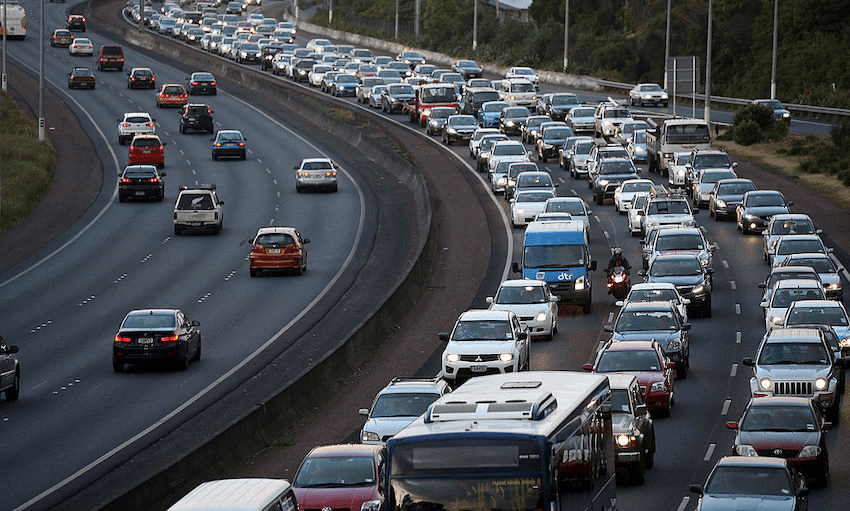As the sharp, lockdown-induced reduction in peak-hour congestion starts to dissipate, let’s not lose this chance to improve Auckland’s legendarily terrible traffic, writes transportation researcher Paul Minett.
The first image below is from 9 March 2020, the second from 20 May, both at about 7:45am during the morning peak travel period. On a typical pre-pandemic morning, the trip along the Northwestern Motorway from a home on the western edge of Te Atatu South to the Auckland CBD could take as long as 49 minutes. During the lockdown it got as low as 17 minutes. Now, as we emerge from lockdown, the travel time is starting to grow once more.
As Auckland’s economic engine restarts, we can expect the traffic to keep building up, and eventually for travel times to look the way they did before Covid-19 shook us all up. That could mean as much as 32 minutes of delay on top of this 17-minute journey, every work day. This example is specific to Highway 16, but the story will be the same all over Auckland.
How long it will take for the traffic to rebuild to the pre-pandemic level is the subject of some conjecture. The variables are how many people will continue to work from home; how many people who used to take the bus will avoid the buses and drive to work; and how many permanent jobs have been lost at the various employment hubs around the region. But with residential construction proceeding apace at the edges of the city, any sort of economic recovery is eventually going to bring traffic congestion roaring back.
Does this have to be what happens? How much delay is really OK? And what could we do if we decided we didn’t want the traffic to be as bad as it used to be?
The Vote Transport section of the 2020 budget sets out a vision for our transport system as providing for inclusive access; healthy and safe people; environmental sustainability; resilience and security; and economic prosperity. How does a 200% delay on the journey to work measure up to those ambitions?
Let’s look at each dimension in turn.
- As regards inclusive access, everyone has an equal opportunity to join the traffic, no question there. But excessive commuting time at both ends of a long work day amounts to a regressive tax that’s worse for those with lower economic means and disabilities. And while Auckland’s transport system is accessible, you would have to agree that the city is not.
- The next dimension of the budget vision is healthy and safe people. Studies have shown that bad daily traffic damages human health through the stress it causes, not to mention extra time breathing emissions from internal combustion engines.
- There can be little argument that the excess fuel burned when taking three times as long to drive to a destination, five times a week, is damaging to environmental sustainability as well as drivers’ pockets.
- In places where there are bus lanes it might be possible for emergency vehicles to get past the traffic but otherwise during peak times the whole system responds badly to an emergency, so that’s a fail for resilience and security.
- Finally, economic prosperity is damaged when the traffic is jammed up. Studies have shown that jammed cities perform below their potential, whereas – as one example – delivery drivers have been loving the extra deliveries they’ve been able to make each day during the lockdown
So Auckland’s terrible traffic clearly does not meet the government’s vision for an urban traffic system. The question is, who should fix the problem, and how?
You might be surprised to know that there’s no reason our traffic has to be this bad. If we think of congestion as just too many drivers driving at the same time given the amount of road, it’s clear that by reducing the number of concurrent drivers we could reduce the traffic and the resulting delays. We could fix this, but it would take a concerted, cooperative effort to do it.
But do we really care enough to make any effort at all?
During my research for an upcoming study on using financial incentives to persuade drivers out of their cars, I found that as many as half of all urban car commuters on a pilot route in California would be prepared to travel as passengers to help reduce traffic, if the deal were right. They would prefer to travel in carpools than on a bus, and travelling as a passenger would have to be made easy. To make the deal good enough, some passengers would expect to be paid for making the effort.
Would this finding hold in Auckland? Could we offer a deal to peak period drivers – who will inevitably jam up the region’s roads again as we move to our new normal – to convince them to travel as passengers instead?
We can only discover the answer if we bother to ask drivers. And is this not an ideal time to start a conversation about what we can do to prevent daily traffic rebuilding to previous levels? Once the traffic comes back, it may be too late.
Paul Minett is a transportation researcher and advocate for alternatives to single occupant vehicle driving who has recently completed a project for the Mineta Transportation Institute in San Jose, California, entitled Congestion-Clearing Payments to Passengers. He lives in Auckland.



